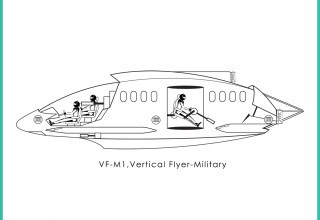With Split Power Engine Technology in Hand, Corporation of Flight, Inc. Enters Vertical Flight Military Market

ATLANTA, March 6, 2019 (Newswire.com) - Corporation of Flight, Inc. (corporationofflight.com) Are the days of long rotor helicopters and runway dependent airplanes numbered? With Corporation of Flight’s newly released Split Power Engine™, vertically lifting heavy loads in a new generation of civilian, recreational, passenger, business, first responder, government, and military aircraft is now a reality. The biggest runway aircraft tops out at around 1.4 million pounds and 232,000 pounds for helicopters. The Split Power Engine, in sight of aircraft footprint, has no practical weight lifting limits. This lift capacity is due to the unique splitting of rotational torque and rotational speed combined with ideal, physics and geometry. With its 50% fuel efficiency design, this combustion engine tech means that passenger aircraft can now be spaces of comfort and entertainment, and heavier loads can be delivered to any location. It also means that the Office of the U.S. President and the U.S. Military becomes, more effective and efficient.
Air Force One, which carries the President of the United States is currently a $350 million passenger aircraft with an as modified $2 billion price tag to be delivered in 2024. “With that type of money and delivery time, and with the revelation of the Split Power Engine, we should now expect more out of an Air Force One presidential aircraft,” says Cambridge Yeno, Corporation of Flight’s marketing director. “They call parts of it the White House, so let’s make it so.” While Air Force One’s current floor space is 4,000 square feet, Air Force Vertical One can be designed having 20,000 square feet, yet the marvelous thing is that its footprint is 50% smaller. Right now Air Force One, as published, has passive defenses such as laser scrambling mirror tech, anti-electromagnetic pulse tech, and diversion flares. Air Force Vertical One will have active defenses to where it can be on the run (or not) while actively engaging threats. “The reality is that the Office of the President is not only an executive position but a commander in chief position of the military as well.” Additional bonuses are also self-evident, vertically take off and land anywhere, more staff and supplies, and ability to carry the presidential limo which can also be a flying car thanks to this technology. “Presidential logistics has high costs, high risks, and large time inefficiencies and this technology can reduce them while reducing financial costs. Some simple math shows that the operational savings possibly equates to the President getting a free vertical aircraft.”
For military applications, the Split Power Engine has the upper hand on any other vertical lift aircraft type from the helicopter and tiltrotor airplane on to vertical lift combat aircrafts due to the Split Power Engine’s ability to provide dragonfly-hummingbird style maneuverability, longer fuel range, reduced radar-sound-and heat signature, shielded fan blades, high altitude ability, variable fuel use, lower maintenance and operating costs, greater lift capacity for payload and more soldiers, and again, its 50% fuel efficiency engine design. “A military aircraft must have all of these features in order to have the greatest effectiveness against threats.” The U.S. Army has recently implemented an up to $100 billion, 4,000+ aircraft, Future Vertical Lift program for original, next-generation vertical takeoff aircraft. To date the only options submitted have been a smaller tiltrotor airplane in which the blades pivot up for vertical flight and forward for horizontal flight and a counter-rotating dual blade helicopter in which the tail rotor is rear facing for greater speed. With minimum required program specifications of, 12 troops, 260 miles per hour speed, 527 miles distance, 6,000 feet altitude, 95 degree Fahrenheit heat operability, tech swapping, 40 x 40 feet max footprint and ability to be autonomous or manned, the Split Power Engine along with the 7 laws of vertical lift can exceed these requirements more than any of these legacy technology platform submissions. More information at www.splitpowerengine.com.
About Company: Corporation of Flight, Inc. is primarily an intellectual property development and licensing corporation focused on 1 person to 100+ passenger Vertical Takeoff and Landing aircraft, for arrivals and departures in any location.
News From Corporation of Flight, Inc.
Contact:
Cambridge Yeno
404-810-1014,
info@corporationofflight.com
Source: Corporation of Flight, Inc.



